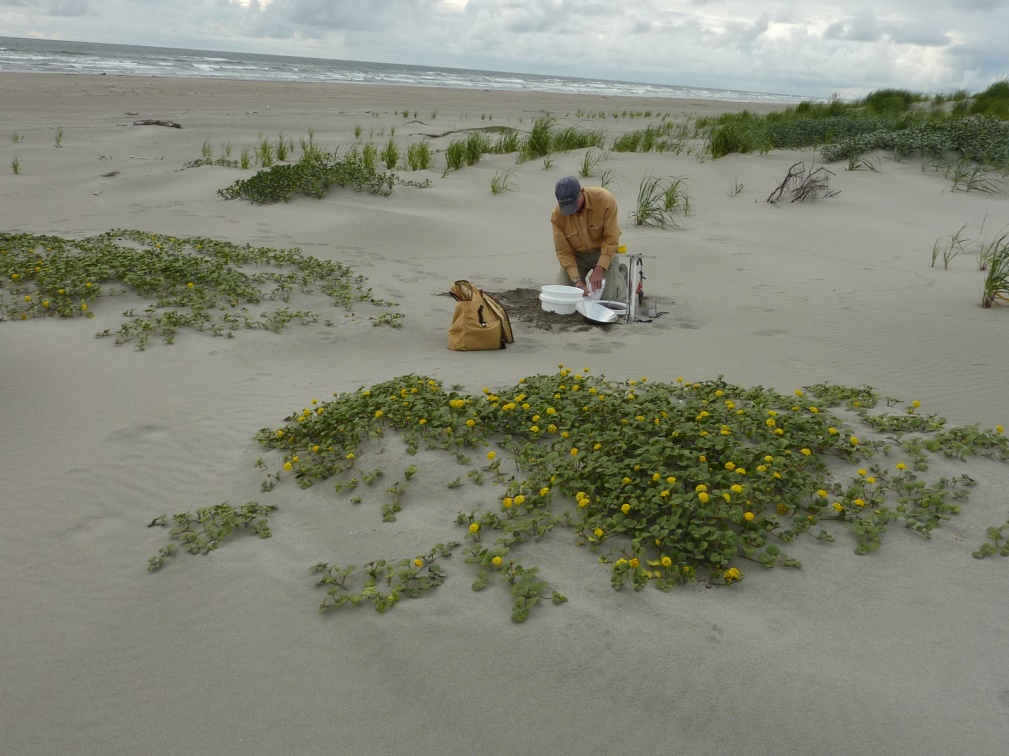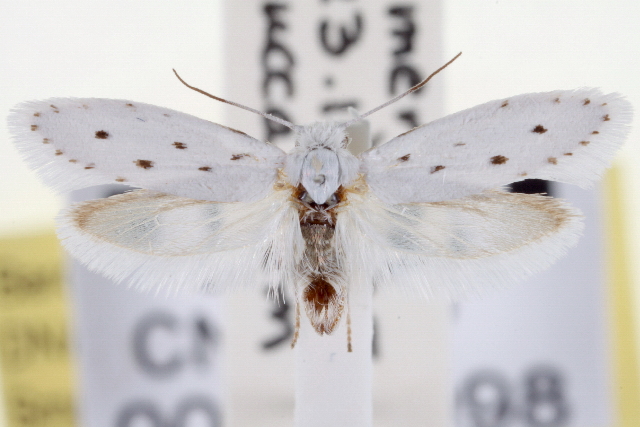
Staffan with Graduate student Jeanne Robert, 2005. Jeanne went on to do a PhD at UBC, then came back to UNBC, where she worked as a post-doctoral fellow and then a Research coordinator for the UNBC NRESi Biodiversity Monitoring & Assessment Program. She is now the Regional Entomologist, Northern Region, for the BC Ministry of Forest, Lands and Natural Resources Operations, Prince George, BC. I was lucky to have a great graduate student. Was she lucky? Only through hard work!
The following is a guest post by Staffan Lindgren
When I was about 10 years old I won a competition in a hobby magazine, which landed me a nice race car track. Since then I have not won anything, really. Yet, I consider myself a lucky person, not only because of a great family life, but because opportunities have always seemed to pop up just when I needed them. But looking back, I would say that my luck was in large part self-made. Over the years, I had made sure I had summer and temporary jobs that gave me appropriate experience, e.g., as a substitute teacher, forest regeneration surveyor, etc.
When I was doing my undergraduate degree in Sweden, the course offerings in the fall of 1973 were not to my liking, so I landed a job as a research assistant to a PhD student studying spiders. But the reason I did, was that I had a longstanding interest in spiders, so I had connected with the student long before that. For example, as a 12-year-old, I wrote to Professor Åke Holm, Uppsala University, after reading a newspaper article posted on a board in my English teachers classroom. Dr. Holm was then Sweden’s pre-eminent spider taxonomist, and had published my first spider book (Holm 1947). His kindness and encouragement has served as a model for me throughout my career. After I graduated with my undergraduate degree, I made a misguided attempt at a PhD in medical endocrinology, studying testosterone secretion in rats. Apart from five small publications (Carstensen et al. 1976, Lindgren et al. 1976, Damber et al. 1977a, Damber et al. 1977b, Bergh et al. 1982), I came away with a bruised ego and a severe allergy to rats.
After my failed 2-year forage into mammal reproductive physiology, I realized that I needed to re-focus on my first love, which was entomology. The first thing I did was to contact (by which I mean that I wrote a letter ) Dr. Bertil Lekander, professor of forest entomology at the Royal College of Forestry, Stockholm, Sweden. He offered to take me on as a special interest student in the two forest entomology courses offered to future foresters. To make a long story short, this led to a life-long association, albeit informal, with Swedish forest entomologists. For example, I published my Master of Pest Management Professional Paper as a Forest Entomology report (which also has a long story associated with it, the main lesson of which is the old adage “It’s not what you say, but how you say it”), and I had the privilege of spending 6 months as a visiting scientist at SLU in Uppsala in 1993 thanks to the connections I made there. Nevertheless, a few courses did not lead to a specific job, so once that was done I was once again without a firm direction in life. Because I had made many friends and connections in the Department of Ecological Zoology at Umeå University, in part through the spider job, but also through volunteering every spring and fall on an annual 4-day microtine rodent survey (Hörnfeldt et al. 1986) I got wind of a 4-month Teaching Assistant position in the Department of Health and Environment, which I was offered (notably in competition with another future entomologist, Anders N. Nilsson, who became a world authority on aquatic beetles). This position involved leading a class trip to the Soviet Union, among other things.

Staffan with a nice rainbow trout from Wicheeda Lake, north of Prince George. Now this may have been luck, because I don’t work hard at my fishing skill!
At the end of that position, I had started the proceedings to go to Canada, which ultimately led me to where I am today. Again, this was not something that happened by accident. In 1968-69, I spent a year in central Michigan as a high school exchange student. This was an extremely formative experience for me. It made me confident that I could succeed in an English-speaking environment, and it shaped me politically (it was the height of the Vietnam War, two political assassinations , Martin Luther King, Jr. and Robert F. Kennedy, Jr., had happened earlier in 1968), and there were significant racial tensions throughout the US. Anyway, I had become convinced that applied science was the only worthwhile pursuit in terms of education (see my earlier post here), and had found the Centre for Overseas Pest Research, a British organization. (Remember that there was no Google or internet, so all of this was done through libraries and by asking for information by mail). I received a letter back that they could only offer employment to “British subjects”, but they passed on a brochure about the Master of Pest Management program at Simon Fraser University. This seemed like the ticket to my future, so I wrote to SFU. The response was positive, so I decided to apply. But I needed funding. Fortunately for me, I managed to land a fellowship from the Sweden-America Foundation, and in combination with the relatively generous student loans from the Swedish Government, I all of a sudden found myself in a position to go to Canada! And the rest is history, as they say!
What does this history of my formative years have to do with luck? I truly believe that some people have more luck than others. When you buy a lottery ticket, the odds are fixed. But in the job market, including academia, you can change the odds in your favour, at least to some degree. The points I take home from the experience I have accumulated over my career are:
- If people know you, they will pass on information that may lead to your big break.
- Treat people with respect, i.e., treat them the way you wish to be treated. If you are well liked and respected, it will make a difference when you are looking for references or recommendations. This is particularly important when dealing with workers. I found that by showing an interest in, and respect for, their experience and knowledge rather than acting superior, you gain their trust and respect, and they will welcome your opinion.
- Don’t hesitate to seek help or advice from professors, no matter how eminent or important they are. In entomology in particular, I have been amazed at the kindness and generosity I have encountered from people really had nothing to gain by responding or talking to me. The worst that can happen is that you don’t get a response, or one that makes you steer clear of that individual (which has yet to happen to me).
- We all have weaknesses. Work on them. I used to shake like a leaf when having to address an audience. Some of the best scientists and public speakers I know suffer from extreme nervousness, but they have learned to cope with it. If you suffer from nerve problems, seek help, or at least give yourself experience. There are tricks to help you, and you’d be amazed how experience helps!
- Never, ever pretend you know something you don’t. Honesty always pays off in my experience.
- Finally, and most importantly, follow your heart. If you are passionate about what you do, you are more likely (and able) to build experience, which in turn becomes as important, or more so, in a job interview.
These are some ways to “make you lucky”. Just like an athlete has to put time and effort into achieving their goals, we do as well.
Best of luck!
References
Bergh, A., J.-E. Damber, and S. Lindgren. 1982. Compensatory hypertrophy of the Leydig cells in hemiorchidectomized adult rats. Experientia 38:597-598.
Carstensen, H., S. Marklund, J.-E. Damber, B. Näsman, and S. Lindgren. 1976. No effect of oxygen in vivo on plasma or testis testosterone in rats and no induction of superoxide dismutase. Journal of Steroid Biochemistry 7:465-467.
Damber, J.-E., H. Carstensen, and S. Lindgren. 1977a. The effects of barbiturate anesthesia and laparotomy on testis and plasma testosterone in rats. J. Ster. Biochem. 8: 217-219.
Damber, J.-E., S. Lindgren, and B. Näsman. 1977b. Testicular blood flow and oxygen tension in unilaterally orchidectomized rats. Experientia 33:635.
Holm, Å. 1947. Svensk spindelfauna. 3, Egentliga spindlar. Araneae Fam. 8-10, Oxyopidae, Lycosidae och Pisauridae. Entomologiska Föreningen, Stockholm, Sweden.
Hörnfeldt, B., O. Löfgren, B.-G. Carlsson. 1986. Cycles in voles and small game in relation to variations in plant production indices in Northern Sweden. Oecologia (Berlin) 68:496–502
Lindgren, S., J.-E. Damber, and H. Carstensen. 1976. Compensatory testosterone secretion in unilaterally orchidectomized rats. Life Science 18:1203-1205.



















